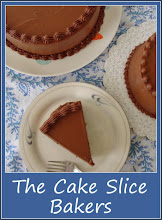My sister and I are very close and have always got on well. Sure, we had our fair amount of arguments and times of jealously, but we were never the kind of sisters who slammed doors in each others faces or screamed we hated each other. Many of my fondest childhood memories involve my sister (and brother too). Things have been a little hectic and crazy for both of us recently and speaking on the phone one evening we realized we hadn’t seen each other, just us two, for several months. This would not do, so diaries were checked and we arranged to meet at her flat for a good ol natter over lunch.
Due to our combined dietary restrictions – vegetarian, coeliac and diary free – we decided to stay in and cook lunch ourselves. We tossed meals ideas back and forth and created our menu. For mains we made a scrummy wild mushrooms & roasted butternut squash risotto and dessert was an unusual citrus drizzle cake made using white wine!
I’d found the recipe for the white wine cake online and it looked so good that I knew we had to try it. It comprised of a lemon and orange scented almond cake, made with oil and white wine, lightly flavoured with cardamom and doused in a white wine and orange syrup. I’ve never seen wine used as a cake ingredient before and as we planned on using a little white wine in our risotto, it seemed the ideal time to give it a go.
So, how was it? Out of this world good! It’s deliciously citrusy, yet not overpoweringly so, surprising considering the amount of citrus that went into it. It’s got a sweet sticky top surface that yields to a moist and tender crumb. It has that wonderfully damp dense almond texture, while still being unbelievably light. We served in with some fresh strawberries but both agreed they weren’t needed. The cake was incredible!
Even though we were both full from lunch neither of us could resist having another slice. It may have been gluten and dairy free but there were certainly nothing lacking in the flavour department with this cake.
The amount of syrup for the cake looks a lot, but the cake just lapped it up and turned it deliciously moist, but not soggy. You don’t want soggy cake people! If you need to feed someone with food allergies – this recipe is sure to be a winner. Even if you don’t have any allergies but have some white wine open – try this – heck open the wine especially to make this cake – it really is that good!
White Wine Citrus Syrup Cake (GF & DF)
(Recipe adapted from Our Kitchen blog)
White Wine Citrus Cake
4 eggs
220g light brown sugar
Zest of 1 lemon
Zest of 2 oranges
½ tsp (6) freshly ground cardamom seeds
100ml vegetable oil
110ml white wine (one with a fruity note is good)
90g Doves gluten free flour
1½ tsp gluten free baking powder
180g ground almonds
Method
Preheat oven to 160C. Grease a 9inch/23cm round springform tin.
In a large bowl beat eggs and sugar together until they become slightly lighter in colour, about 2 minutes.
Crush and grind the cardamom using a pestle and mortar and it to the eggs along with the lemon and orange zest.
Gradually drizzle in the oil and wine, whisking all the time.
Scatter over the flour, baking powder and ground almonds and fold in using a spoon or spatula.
Pour the mix into the tin and bake for 45-50 minutes. It will be a light golden colour, springy to the touch and have a shiny top surface when cooked.
Meanwhile, make the syrup (below) to drizzle over the cake once cooked.
When cooked, remove the cake from the oven and allow to cool for 5 minutes in the tin before removing to a serving plate.
Prick the top of the cake with a skewer or fork before pouring over the cooled prepared citrus syrup. You mat need to do this in 2 or 3 intervals, to allow the cake to absorb the syrup. Leave for at least 30minutes before cutting.
Keeps well for 3-4 days. The cake gets even moister and sticker the longer it sits.
Orange Syrup
110ml white wine
Juice of 2 oranges (use the zested ones left from making the cake)
75g caster sugar
6 cardamom pods
Method
Crush the cardamom pods and place the little black seeds into a saucepan. Add the wine, sugar and orange juice. Heat gently until the mixture comes to the boil; then reduce to a simmer and allow to bubble for 10 minutes. Then remove from the heat and sieve the syrup into a jug to remove the seeds and set aside to cool.
Green Bean Slaw
6 hours ago

























































